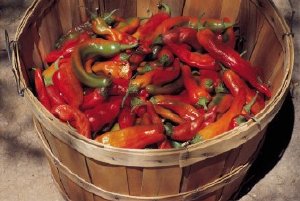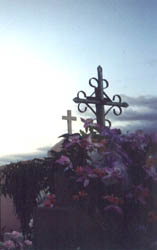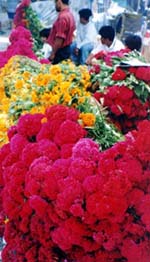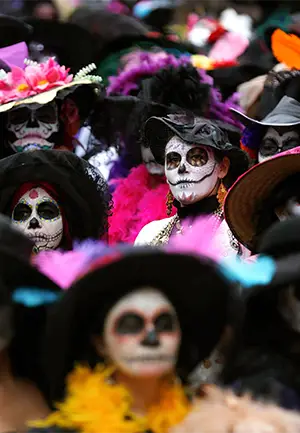The Realm of Fascination is a knowledge base for The Good Cemetery guide. Learn more about what inspired the book:
AUTHOR | THE BOOK | RITES | DIGITAL | ART | BOOKS | GALLERY | ABOUT KALK BAY | ABOUT MEXICO
In Central Mexico, time and place are fluid, and history runs into the present, and the present is always straining into the afterlife so that nothing is only what it seems.
National Geographic August 2007, Mexico’s Pilgrim Cowboys, Alexandra Fuller
The Road to Mictlan
“His favourite drinks have not been forgotten in case he is thirsty after the long trip from Mictlan, the underworld and resting-place for the dead. And there is music playing in the background and women roving around like dark feathers in the soft candlelight.”
The Good Cemetery Guide
The concepts of Mictlan (place of the dead) and Xibalba (watery underworld) are significant in the funerary traditions of Mexico. Since 1500 BCE, or possibly earlier, there has existed in Mexico elaborate ceremonial practice grounded in a native cosmology, evidenced by art making, burial practices and pictorial manuscripts. After the invasion of the Spanish and the introduction of Catholicism, ancient Mexican and Mayan conceptions regarding life, death and the afterworld were incorporated into a syncretic Mexican Catholicism and its calendar of festivals and saint days. One of the more notable ceremonies that continue to honour the dead in contemporary Mexico is the annual Dia de los Muertos festival, a creative, art based, funerary tradition practiced for centuries in Mexico and more recently innovated in Chicano/Latino communities in the United States.
The history of Mexico
The Mexican people, tired of the unbalanced distribution of wealth and power, initiated the Mexican Revolution in 1910. The 10-year civil war resulted in the death of at least 2 million Mexicans.
Mexican faith
…It’s as if everything may happen (the mare may revolt, the cowboys may burst into prayer, miracles may ensue) or nothing will happen at all (the mare will take one breath after another, the cowboys will dismount and make for their construction jobs, the roosters will find a dusty nest and fall asleep). In the end, because this is central Mexico, something entirely other happens out of the dawn, thousands of cowboys on a mix of mounts from eager stallions to a black-and-white spotted donkey appear. Pilgrimages to Christo Rey, to Our Lady of Guadalupe, to depictions of saints elsewhere in the country are common in Mexico. But seldom is there such a massive cabalgata – a horse-back gathering – of faith.
…”We have endured something together. This has made us forget our differences, so we pray for peace in ourselves, for peace in Mexico, for peace in all the world.” – Marco Antonio González Guerrero, pilgrim cowboy.
National Geographic August 2007, Mexico’s Pilgrim Cowboys, Alexandra Fuller
Mexican food
“A small boy with oily black hair and a wide sombrero stretches out a brown hand from under a striped poncho and offers him a ripe tomato from a basket at his feet. He tastes the soft sweet pulp between his teeth, warm in his mouth, and the juice drips falling onto the red sand.”
The Good Cemetery Guide
Mexican Recipes
Sugar Skulls are used to adorn homes during the most important holiday of the Mexican Calendar, the Day of the Dead on Nov 1st and 2nd.
Day of the Dead
“In the United States the word death burns the lips, but the Mexican lives close to it, jokes about it, caresses it, celebrates it, sleeps with it, it is his favorite toy.” Octavio Paz
~ ~ ~
For foreigners, the traditions and celebrations in Mexican homes and cemeteries during the Day of the Dead seem strange, if not incomprehensible. There is mourning and rejoicing; sadness and silliness – woven together into one emotional fabric. To me, it’s like welcoming the return of a dear friend or relative, who moved far away and visits just once a year. Mexicans try very hard to be with their families for this fiesta, as the living and the dead gather for the most complete of family reunions. The Day of the Dead activities actually span several days, beginning late at night Oct. 31, when the spirits of dead children (angelitos) start arriving, followed by adult spirits sometime during Nov. 1. They leave, after joining in a family meal, on Nov. 2. Although exact times for the spirits’ entrances vary from pueblo to pueblo, the angelitos always arrive ahead of the adults.
I grew up in a French-Canadian Catholic family. From an early age, I believed that when you died, you put on a white satin smock with lace around the cuffs and joined the anonymous army of souls (in heaven if you were lucky). Mexicans have a distinctly different view of themselves in the afterlife. First, you keep your identity, since to return to this world for the Day of the Dead, you must remain who you were. This explains the profusion of skeletons of all sizes, doing ordinary day-to-day things. If uncle José was a barber, he continues as a barber after death. Placing a skeleton figure of a barber on your altar reaffirms to uncle José that he has not been forgotten on his spiritual return.
Most Oaxacan homes have a highly adorned Day of the Dead altar. Sugar skulls with the names of dead loved ones inscribed in their icing indicate to the returning spirits that they have indeed returned to the right spot, where the living await their arrival. The altar is a sort of landing pad and its objects serve as signals to guide the spirits home. Throughout the year, but especially during the Day of the Dead season, calacas, or skeletons, are displayed in shops throughout the city. In the Abastos market, for a few pesos each, you’ll find cardboard, wire and cotton-ball figures depicting nearly every walk of life. The more upscale folk art stores display elaborate ceramic and paper mache calacas, individually signed by renowned Mexican folk artists.
Karen Hursch Graber: www.mexconnect.com
~ ~ ~
Mexico’s DÃa de Muertos celebration: Is it dying?
“Every year there are more and more tourists. They’re not coming to see our tradition, they just want another reason to have a fiesta. It gets worse later, when they start urinating on the candles.”
Yuri Awanohara: www.mexconnect.com
The Mexican language
! Hola Chickita!
Dia de Muertos
! Madre de Dios!
Pan de Muerto
– Hello girl/little girl/woman/! in Spanish.
SLANG: Hey there hot chick!
– Day of The Dead
– Mother of God!
– Bread of death
Mexican Punctuation
¿? (signos de interrogación)
In Spanish, question marks are used at the beginning and the end of a question. If a sentence contains more than a question, the question marks frame the question only. Si no te gusta la comida, ¿por qué la comes? If you don’t like the food, why are you eating it?
¡ ! (signos de exclamación)
Exclamation points are used in the same way that question marks are. If a sentence contains a question and an exclamation, it is OK to use one of the marks at the beginning of the sentence and the other at the end.
Vi la pelÃcula la noche pasada. ¡Qué susto! I saw the movie last night. What a fright!
¡Qué lástima, estás bien? What a pity, are you all right?









